
Tobacco and Medicine Menu: 1 2 3 4 5 6 7 8 9 10 11 12 13 14 15 Next>>
Tobacco and Medicine During the Golden Age of Piracy, Page 3
GAoP Sailors, Pirates and Tobacco
“The necessity of Tobacco, and maintaining the Plantations of it, is almost as great, if we do but consider who they are that buy it only for their own drinking [smoking], and cannot abstain from it. Sea-men will be supplied with it for their long voyages: Souldiers cannot want it when they keep guards all night, or are upon other hard duties in cold and tempestuous weather: Farmers, Plough-men, Porters, and almost all laboring men plead for it, saying, they find great refreshment by it, and very many would as soon part with their necessary food, as they would be totally deprived of the use of Tobacco.” (Giles Everard, “The Epistle”, Panacea, or the Universal Medicine, 1659, not paginated)
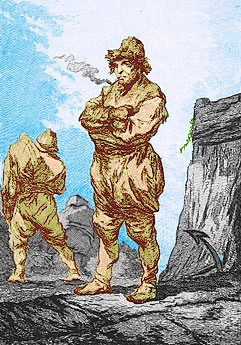
Artist: Phillipe Jacques de Loutherbourg
A Sailor Smoking, (mid 18th century)
Although it appears to have enjoyed continued popularity among sailors, tobacco continued to be mentioned primarily in passing in most of their accounts during the Golden Age of Piracy (GAoP). For example, when merchant sailor Francis Rogers was in Aden (located in what is presently Yemen) in 1702, he commented that the local ship's clerks "entertained us with tobacco in their long pipes of a yard and a ½ long, and coffee, sitting cross-legged on their mats on the floor, as we likewise did"1. When Edward Barlow was dining with a merchant in Mocha (also presently in Yemen) in 1697, he said, "After we had dined we sat along with them in another room, and they that would smoke tobacco might."2 (Although a sailor for most of his life, Barlow actually gives no indication that he was a smoker.)
Merchant sailor George Roberts was definitely a smoker. In his book, he mentions the habit several times, particularly while performing tedious tasks. He talks about pumping the water out of his leaky vessel the Dolphin, explaining the he would pump for about half an hour "after which I rested... and smoak'd a Pipe of Tobacco, and took a Dram of Rum with a little raw Rice, and then fell to my Work of' Pumping"3. He mentions this frequently in that passage and several times more elsewhere in his book.4 It should be noted that although the author of this book was clearly a smoker and had knowledge of sailing and sailors, it is not clear whether the character of Roberts was real or a fictional construct.
Sea surgeon's mate Roderick Random, a fictional construct of former sea surgeon's mate Tobias Smollet, notes that upon learning that his wounded leg was to be amputated, one of his patients began "recruiting himself with a quid of tobacco, [and] pronounced, with a woeful countenance, 'What! is there no remedy, doctor?'"5 Fictional or not, smoking is clearly linked to sailors in such passages.
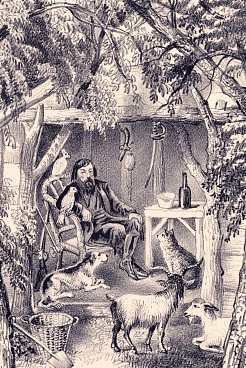
Artist: Courier & Ives
A Fanciful Telling of the Selkirk Legend, "Robinson
Crusoe and His Pets", (c. 1874)
Tobacco is one of the things that kept stranded sailor Alexander Selkirk (the real-life model for Robinson Crusoe) company on Juan Fernandez Island. Upon picking Selkirk up in 1709, Woodes Rogers reported, "He had with him his Clothes and Bedding; with a Firelock, some Powder, bullets, and Tobacco, a Hatchet, a Knife, a Kettle, a Bible, some practical Pieces, and his Mathematical Instruments and Books. He diverted and provided for himself as well as he could"6. It is not clear how he had managed to still have tobacco after four years and four months of solitude on the island. It is possible that it may have been growing there. Note that a pipe is not mentioned.
One of the more direct indications of the importance of tobacco among sailors come from Navy midshipmen Clement Downing. He explains that upon arriving at his post in Bombay in October 1721 aboard the HMS Salisbury, a court martial was underway. The purser of the warship Exeter, Mr. Savage, was accused of (among other things), taking "the Government's Money, in order to supply such Necessaries as are proper for so long a Voyage; but had not supplied the Ship with any Tobacco, nor Slop Goods, as is customary for Gentlemen in his Post."7
Snuff was around during this period, although it is not mentioned very often in the accounts of sailors. Francis Rogers notes that while he was visiting Cork, Ireland that "A little tobacco or snuff is very acceptable to them, they’ll do much for that."8 However, he never says he or any other sailors used it in his voyage. Woodes Rogers states the Brazil is well known for producing "Red Wood, Sugars, Gold, Tobacco, Whale-Oil, Snuff, and several sorts of Drugs.
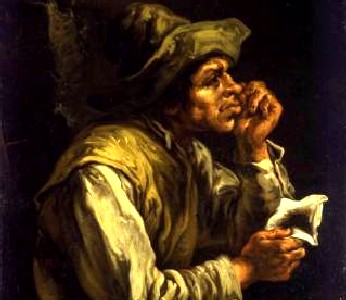
Artist: Guiseppe Antionio Pianca
Man Taking a Pinch of Snuff, (c. 1750)
"9 Like Francis Rogers, however, he never mentions any sailors using it. Neither does Edward Cooke, author of the other book about the same journey. Woodes Rogers does note that one of the Spanish prize ships, the Marquis, did not sail well, they chose "to heave the Dutchess’s two heavy Guns overboard, and 20 Boxes of Snuff, with two spare Topmasts, and bring his Ship more to Stern"10. Apparently snuff was not in favor with the mostly English crew of Rogers' voyage.
The only direct reference to sailors using snuff comes from George Shelvocke's privateering voyage around South America, from 1719-22. His crew stopped at Cabo San Lucas, Mexico (which he calls Puerto Seguro) to renew their supply of water. Shelvocke explains that the natives there "would always have the mastery of us, and that was in taking snuff, which they would never permit any of us to use; but immediately upon seeing any of us take a pinch out of our boxes, they would run to us, and with great earnestness take it from between our fingers, and throw it away."11 He speculates on why the natives might have done this, but the interesting takeaway from the citation is that at least some of the sailors took snuff (after being almost 2 years at sea). There is an indirect reference to snuff tobacco in Charles Johnson's account of the three ships sent to Port au Prince from Providence, Bahamas to establish trade by Governor Woodes Rogers. It was noted that supercargo James Carron that voyage, formerly a midshipman on HMS Rose had a silver snuff box among his possessions.12 Similarly, when Peter Solgard engaged pirateEdward Low's sloops and caught one, the corporation of New York "presented him with his Freedom of the City; as also with a Gold Snuff-Box, having the City Arms on one Side, and the Greyhound engaged with 2 Pirate Sloops on the the other, with this Motto, viz. Quaesitos Humani Generis Hostes deballard superbum. [Roughly: The enemies of the human race were sought and conquered by this man]"13.
While there are not a lot of period references to pirates using tobacco, there are at least as many as are found in the merchant
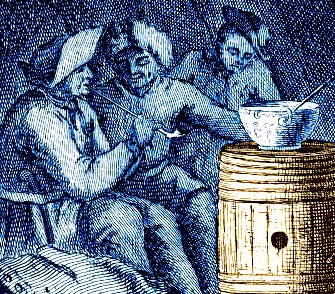
Artist: Joseph Nicholls
Lowther's Men Smoking and Drinking (1736)
and navy sailors accounts from this time. Smoking among the pirates appears to have been one of those things so common that it was not worth mentioning in and of itself.
Several of the references to tobacco come from mutinies. When John Hay, master of the Windbound overheard his crew discussing mutiny while off the Island of Madeira, "lest they should murder him in his Cabin, he went upon Deck, where walking the Quarter, smoaking his Pipe"14. Fortunately for Hay, the crew put him in a small boat with bread, water and cheese rather than kill him and let him make his own way to land. (It doesn't mention whether they let him take tobacco with him.) When Acadian John Baptiste Jedre (or Guedry) took over the English fishing sloop Tryal off Acadia (near present day northern Maine), he "took the Vessel’s Biscake [biscuit], Butter and Cheese, and made use of the Sugar, Tobacco and Pipes"15. During the trial of Henry Every's men, cabin boy John Sparkes testified that after the mutiny aboard the Charles the Second (thereafter renamed the Fancy) he "was kept onb[oar]d by ye comp[any] but as a kind of slave to wash their clothes, sweep the decks and light their pipes"16.
Tobacco was sometimes a necessary part of pirate ceremony. While a trial was being arranged for men suspected of trying to leave Bartholomew Roberts' crew in the steerage,
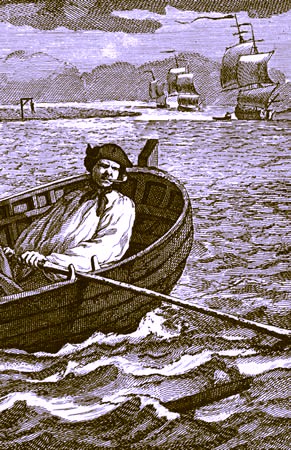
Artist: William Hogarth
The Idle Prentice turn'd away and sent to Sea, From
the
Industry and Idleness Series, Plate 5 (1747)
is is explained that "a large Bowl of Rum Punch was made, and placed upon the Table, [and] the Pipes and Tobacco being ready, the judicial Proceedings began"17. The description of the trial itself is very brief and the judgement was about to be announced "when one of the Judges mov'd, that they should first Smoak t'other Pipe; which was accordingly done."18
Tobacco was also used by captain John Rackam's men to coax some small boat sailors aboard the pirate vessel so they could get them to join the crew. The nine men, who were in a periauger [called in the text a 'pettiauga'] ran away from them to shore when Rackam's sloop appeared. The pirate crew told them men they were English "and desired the Pettiauga's Men to come on Board, and drink a Bowl of Punch... but they had no sooner laid down their Arms, and taken up their Pipes, but [Jonathan] Barnet's Sloop [Tyger], which was in Pursuit of Rackam's, came in Sight."19 These new recruits were summarily captured after the ensuing battle.
A variety of examples of tobacco use among the pirates appear in George Roberts' book. In the book, Roberts' sloop Dolphin is captured by Edward Low and kept by the pirates for ten days. A great deal of tobacco smoking took place while the pirates were 'lying to', enjoying the fruits of plundering Roberts' boat and deciding what to do with him. Early on, Roberts explains that during one evening, "no body had any thing to do, but the Lookersout, at the Topmast-head; the Mate of the Watch, Quarter-master of the Watch, Helmsman, &c. being gone down to drink a Dram, I suppose, or to smoak a Pipe of Tobacco, or the like."20 When the pirates were going to discuss Roberts' fate, they left him in a cabin with alcohol, pipes and tobacco, where he "sat
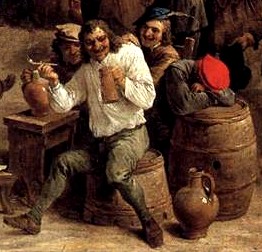
Artist: David Teniers the younger
Peasants Smoking and Drinking (1650)
still and smoak'd a Pipe of Tobacco"21. Once they had voted to give him back his vessel, the tension was broken "and every Body talked according to their Inclinations, the Punch, Wine, and Tobacco being moving Commodities all this Time"22.
While staying with the pirates, Roberts was constantly threatened by the captain of one of Low's consort ships, John Russell. To keep Roberts from being attacked by Russell during the night, other crew members "would sit up with me all Night for my greater Security: Which they did, smoaking and drinking and talking, every one according to his Inclination, and so we pass'd the Time away 'till Day."23 One evening, he stayed up with Low himself and "two or three of his Confidents, [and we] smoak'd a Pipe, and drank a Bottle or two of Wine"24. Russell disliked Roberts so much that he removed almost everything that might be useful from the Dolphin as the pirates were preparing to sail away from Roberts. However, he did leave him with a musket and powder and also "gave me also two half Pound Papers of Tobacco", so that as the pirates sailed away, "finding a short broken Pipe in the Cabbin, I smoak'd a Pipe"25.
1 Francis Rogers. from Bruce S. Ingram's book Three Sea Journals of Stuart Times, 1936, p. 174; 2 Edward Barlow, Barlow’s Journal of his Life at Sea in King’s Ships, East and West Indiamen & Other Merchantman From 1659 to 1703, p. 482; 3 George Roberts, The four years voyages of Capt. George Roberts, 1726, p. 119; 4 See Roberts, pp. 119, 121 & 139 for examples; 5 Tobias Smollett, The Adventures of Roderick Random, 1748, p. 185; 6 Woodes Rogers, A Cruising Voyage Round the World, 1712, p. 126; 7 Clement Downing, A Compendious History of the Indian Wars, 1737, p. 85; 8 Francis Rogers. from Bruce S. Ingram's book Three Sea Journals of Stuart Times, 1936, p. 197; 9 Woodes Rogers, A Cruising Voyage Round the World, 1712, p. 52; 10 Woodes Rogers, p. 242; 11 George Shelvocke, A Voyage Round the World by Way of the Great South Sea, 1726, p. 408-9; 12 Daniel Defoe (Captain Charles Johnson), A General History of the Pyrates, Manuel Schonhorn, ed., 1999, p. 630; 13 London Journal, 10-19-23, Issue CCXXI; 14 The American Weekly Mercury, Thursday May 21st. To Thursday May 28th. 1724; 15 The Trials of Five Persons for Piracy, Felony and Robbery, 1726, p. 11; 16 “3. John Sparks. The Examination of John Sparks, 10 September, 1696. HCA 1/53, f. 18”, Pirates in Their Own Words, Ed Fox, editor, 2014, p. 36; 17,18 Defoe (Captain Charles Johnson), p. 222; 19 Defoe (Charles Johnson), p. 150; 20 Roberts, p. 52; 21 Roberts, p. 56; 22 Roberts, p. 71; 23 Roberts, p. 77; 24 Roberts, p. 82; 25 Roberts, p. 101
GAoP Sailors, Pirates and Tobacco - Purchasing Tobacco
There are a variety of accounts which mention the
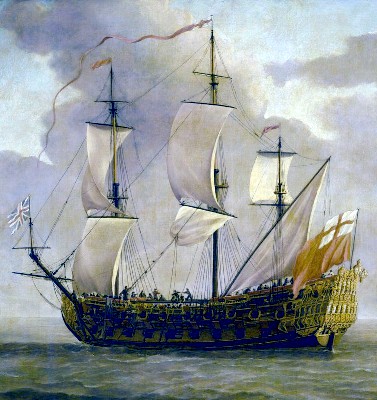
Artist: Willem Van de Velde Elder - HMS Woolwich, 4th Rate Naval Vessel (c. 1677)
purchase of tobacco by ships during the golden age of piracy. The British Navy actually had regulations regarding the purchase of tobacco by it's sailors, first printed in 1731. Although this is after the time period of interest, many (if not all) of these rules were in force in some form or other prior to their formal recognition. As the introduction in this document explains: "the Orders and Instructions, which have from Time to Time been issued for the better Government of the Navy, have been so imperfect and, through Length of Time, become so perplexed... that, for the preventing any Doubts or Difficulties of this Nature for the future, they have
collected into a Book the several Rules and Orders now in Force in the Navy"1.
Article XXXI relating to the purser states that he is "in some publick Place upon Deck, to issue out to such Seamen as do smoak, and shall desire it, cut and dried sweet scented Tobacco, not exceeding Two Pounds per Month to a Man, at the Rates settled by the Navy-Board."2 Article XXXV in the 1735 Purser's Instructions further notes that the purser "is to keep… a Tobacco Book, which he is to deliver into the respective Offices, before the Pay of the Ship."3
Merchant and privateering voyages also bought tobacco for their crews. In the stores for the Mary Galley, a 170 Ton merchant vessel which was supposed to have 30 men aboard (23 actually sailed on the voyage in the account) which was going to India in 1704, the victuals purchased for her included 8 hundred weight of tobacco and 40 gross pipes (5760 total).4 Merchant captain George Roberts said that when he reached the Isle of May in Scotland, he met five ships loading salt, from "among whom we got some Water, and also Tobacco, the Want of which had almost brought a West-Country Famine on us, as the Sailors used to term it."5 Although Roberts says this is a typical term used by sailors, it is is only found in one other book, which happens to have been written the same year. While off of Cabo Frio, Brazil in 1719, privateer George Shelveocke sent his boat to the mainland "to enquire what news on the coast, and gave him
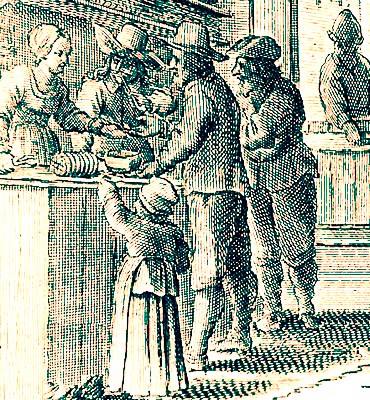
Artist: Adriaen van de Venne -
A Dutch Tobacco Shop (early 17th c.)
money to buy some tobacco for the Success had got our stock aboard of that (as well as other things) which created West-country famine amongst us."6 Shelveocke also purchased "a very necessary article, viz. a good stock of tobacco" in August of 1719 while anchored at Santa Catarina Island in Brazil.7
Another privateer, Woodes Rogers, similarly sent their boat to Santo Antonio on Principe island in October of 1708 to recruit a guide for the area. However, as Rogers somewhat sourly noted, "Our Boat return'd with nothing but Limes and Tobacco, and no News of our Linguist [guides were sometimes called linguists]."8 This was soon followed by another boat from Principe looking to sell items to the English privateers, including "Limes, Tobacco, Oranges, Fowls, Potatoes, Hogs, Bonanoes, Musk and Water-Melons, and Brandy, which we bought of him"9.
The English merchants were not alone in their need for tobacco on their ships. While in the Philippines in 1686, diligent observer William Dampier explained, "The Dutch come hither [Mindanao] in Sloops from Ternate and Tibore, and buy Rice, Bees-wax, and Tobacco; for here is a great deal of Tobacco grows on this Island, more than in any Island or Country in the East-Indies, that I know of, Manila only excepted."10
Pirates are not usually associated with purchasing their commodities, but sometimes needs must. Among the goods that the enterprising Captain Jacobs brought to sell to the Madagascar-based pirates in 1698 were "Tobacco Pipes 6 Ryales a dosen."11 For those keeping score, the Spanish real was 1/8 of a piece of eight. So 6 reals would be 6/8 or 3/4 of a piece of eight for a dozen pipes. By way of comparison, a tankard of beer from Jacobs was one piece of eight.
1 Great Britain Privy Council, “The Purser”, Regulations and Instructions Relating to His Majesty’s Service at Sea, 1731, p. ii; 2 Great Britain Privy Council, p. 125; 3 Great Britain Privy Council, p. 126; 4 Thomas Bowrey, The Papers of Thomas Bowry, 1669-1713, Part 1, 1927. p. 194-5; 5 George Roberts, The four years voyages of capt George Roberts, 1726, p. 10; 6 George Shelvocke, A Voyage Round the World by Way of the Great South Sea, 1726, p. 16; 7 Shelvocke, p 52; 8,9 Woodes Rogers, A Cruising Voyage Round the World, 1712, p. 27; 10 William Dampier, A New Voyage Round the World, 1699, p. 228; 11 “67. Prices of Pirate Supplies: A List of the Prices that Capt. Jacobs sold Licquors and other Goods att, at St. Mary’s, 9 June, 1698…”, Pirates in Their Own Words, Ed Fox, editor, p. 363
GAoP Sailors, Pirates and Tobacco - Trading and Selling Tobacco
Tobacco was actually used like money to purchase necessary items in the American colonies. Historian William Tatham
Bird Plantation in Virginia, Apparently Drawn by a Child (c. 1700)
says that around 1640, "tobacco was introduced in lieu of specie [coined money], as a kind of circulating medium, and as the measure of Price and value in Virginia negociations"1. Tatham goes on to say, "I find amongst the colonial records about this period, various provincial acts for making tobacco a legal tender from individual to individual, as well as in discharge of public
obligations... he who kept a public house was compelled to sell a dinner or a draught of beer for an equivalent in tobacco leaves"2.
Tatham is not clear on how long this 'system' was in use in Virginia, noting that the wars with the Dutch between 1652 and 1674 dominated the records to which he had access limiting his ability to suggest the time period during which this was done. However, while in Virginia in 1701, traveler Francis Louis Michel wrote, "tobacco is the principal article there with which trade is carried on. It passes for money... All purchases or payment are made in tobacco."3
However, the spirit of purchasing with tobacco was certainly alive and well on ships and by sailors in trade for other things during the golden age of piracy, particularly when they made landfall. While surgeon to a whaling boat in the late 17th century, Johann Dietz said that the sailors gave Eskimos they encountered "brandy and tobacco from our small store, which to them was highly acceptable. In return they brought us reindeer milk and cheese, dried fish and smoked eel and salmon, a considerable quantity of furs, and some whalebone and other matters"4.
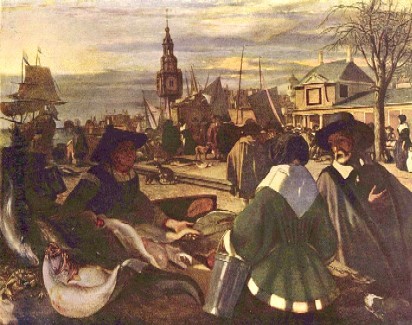
Artist: Emanuel de Witte -
A Sea Side Market Scene (1680)
Similar trades could be made for tobacco closer to the regular trade routes. While on Nicowry Island in the Nicobars off India in the late seventeenth or early eighteenth century, sailor Alexander Hamilton said of the locals, "Tobacco they are very greedy of, for a Leaf of Tobacco, if pretty large, they will give a Cock"5. Captain Thomas Phillips explained that when he was in Whydaw, Africa in 1694, "For a pound of leaf tobacco, be it never so rotten and bad, we could buy one of these cloths [made by the locals], which would yield a crown in Barbadoes; also one for eight knives, value prime cost eighteen pence."6 Francis Rogers was on Saddle Island near Madagascar in 1702 where he found "A piece of an old shirt, a three-halfpenny knife, or a handful of tobacco will purchase a fowl or two, or plenty of green trade [fresh green edible plants]"7.
There are a number of instances of trading tobacco found in sailor Edward Barlow's journal during his forty-four year career at sea. In 1663, Barlow was aboard the merchant ship
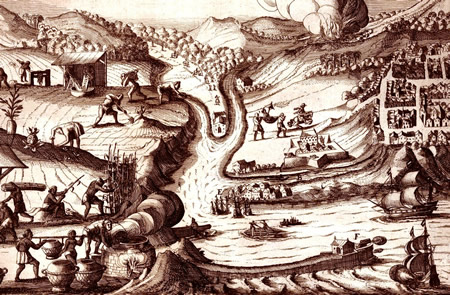
A Sugar Plantation in Brazil, From Reys-Boeck van het rijcke Brasilien (1624)
Queen Catherine in Brazil where they "filled the ship, being laden very deep" with 900 chests of sugar sugar, but they also managed to squeeze "some tobacco and hide" aboard.8 Barlow may be referring to officers' private cargos, which were purchased by them to be sold for a profit upon the return to England. This was a commonly practice among officers, including by Barlow himself. Barlow was aboard the merchant ship fflorentine which sunk off Deal, England in October 1675. His sailor's chest was saved; when he got it back, he found it contained "four rolls of tobacco out of nine which I had on board, which the Deal men had brought ashore from our ship"9. When he reached Marseilles, France months later, Barlow explains, "I sold my four rolls of tobacco to a Frenchman, and got twelve pence a pound for it, which money did help me well after my shipwreck and loss."10 Since Barlow never mentions smoking personally and he still retained the same number of rolls after several months, it is almost certain that he bought the tobacco as an investment with an eye towards selling upon returning home.
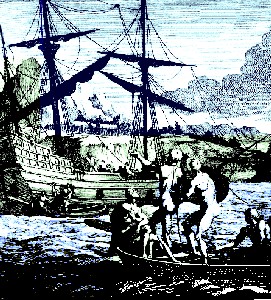
Natives Selling to Ship, From Versameling der
Gedenk-Waardigste zee en Land-Reysen na Oost
en West-Indien, Vol. 15, p.52
Barlow also talks about trading tobacco for other desirable commodities. Before she sunk, the fflorentine was in Norway where he noted that the Danish "loved good drink very well, and tobacco, and for two or three pipes of that, they would give us four or five great lobsters, each of them if they had been in London would have been worth two shillings the piece"11. While on the West Indiaman Gunnaboe four years later in the Gulf of Mexico, their ship was approached by natives offering "a kind of earth or gum which they seem to prize very highly, yet they will part with it for any old rags, or knives or scissors, or any old hatchet or saw, or leaves of tobacco, or any other suchlike trade."12 Barlow returned to the Gulf in 1681 on the Cadiz Merchant where Native Floridians boarded their ship to trade "the gum of some tree or some kind of mixed earth... making as though they prized it very highly; but they would sell it for small matters – for old broken knives and scissors, and old rags or stinking tobacco."13
The Cape of Good Hope in Africa was an excellent place to trade tobacco. Barlow explained that in 1689, he visited the Dutch settlement on island of Mauritius where "they plant and make very good tobacco, which they sell to their [East India] Companies at eight or nine stivers the pound and they carry it to the Cape 'Bonsprance' [Cape of Good Hope] and there sell it to the "Hottontodes" or country people for their cows and sheep to provide fresh provisions for their ships that touch there going and coming from Holland."14 Privateer William Dampier visited the Cape two years later, where he similarly found "that the Inland Hottantots have still great stocks of Cattle, and sell them to the Dutch
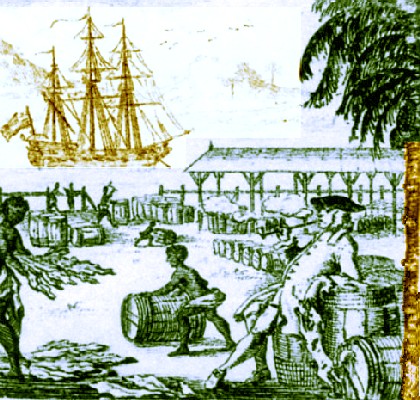
Shipping Tobacco, From an Archer's Best Virginia Tobacco Trade Card
for Rolls of Tobacco: and that the price for which they sell a Cow or Sheep, was as much twilled Tobacco, as will reach from the Horns or Head, to the Tail; for they are great lovers of Tobacco, and will do any thing for it."15 Sailor William Funnell explained that while at the Cape in 1705, the locals were "great Lovers of Tobacco; and for two or three ounces of it, a Man will not stick to prostitute his Wife to any European whatsoever."16 This is confirmed in another account given by Captain Antony Cowley, who was at the Cape in 1686 with Dampier. He said that the natives there approached "with an offer to the Hollanders, that they should lye with their Wives for a bit of rolled Tobacco."17
Tobacco was valuable enough for selling and trading that some sailors planted it themselves when visiting the lush environment of Caribbean islands in expectation of bringing it back home with them to sell on the return voyage. Professor Clarissa Therese Kimber explains,
Ship captain, after reaching the Caribbean, planned on settling into one of the Lesser Antilles where the agricultural situation was suitable to plant a field of tobacco, with the intention of harvesting it just before returning to home ports at the end of the season. ...it is known that the company of the shipwrecked Lavrette [mid 17th century] planted tobacco on Dominica in anticipation of their return to France.18
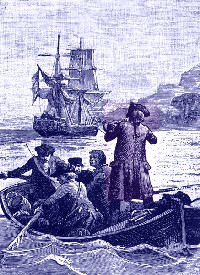
Artist: George Roux
Heading for Shore (1885)
Charles Johnson twice mentions trading tobacco in his first book The General History of the Pirates. The first is from an aside on the islands of St. Thome, Del Principe and Annabono from the chapter on Howell Davis. Here he says the locals barter very cheaply: "A good Hog for an old Cutlash, a fat Fowl for a Span of Brasil Tobacco, .(no other Sort being valued, &c.) But with Money you give ...six Dollars for a grown Hog, a Testune and a Half for a Fowl"19. Note that he doesn't suggest that Davis' pirates traded tobacco for anything while there.
The sole example of pirates actually offering tobacco for something in return comes from some of Walter Kennedy's men. After Kennedy had captured a Quaker's ship - Captain Knott - eight of Kennedy's men decided to quit the pirate life and travel back to the colonies aboard Knott's vessel. "They made the Quaker a Present of 10 Chests of Sugar, 10 Rolls of Brazil Tobacco, 30 Moidors, and some Gold Dust, in all to the value of about 250 l. [pounds]"20 Being a peaceful man, Knott let the pirates have their way on the ship, delivering them to Maryland. Once they had left, he reported them to the governor and surrendered all the goods they had given him.
1 William Tatham, An Historical and Practical Essay on the Culture and Commerce of Tobacco, 1800, p. 179; 2 Tatham, p. 192; 3 Francis Louis Michel, Translated by William J. Hinke, "Report of the Journey of Francis Louis Michel from Berne, Swizterland, to Virginia, October 2, 1701 - December 1, 1702", Virginia Magazine of History and Biography, January 1916, p. 30; 4 Johann Dietz, Master Johann Dietz, Surgeon in the Army of the Great Elector and Barber to the Royal Court, 1923, p. 139; 5 Alexander Hamilton, British sea-captain Alexander Hamilton's A new account of the East Indies, 17th-18th century, 2002, p. 374; 6 Thomas Phillips, A Voyage Made in the Hannibal, 1694, p. 220; 7 Francis Rogers. from Bruce S. Ingram's book Three Sea Journals of Stuart Times, 1936, p. 161; 8 Edward Barlow, Barlow’s Journal of his Life at Sea in King’s Ships, East and West Indiamen & Other Merchantman From 1659 to 1703, p. 85; 9 Barlow, p. 264; 10 Barlow, p. 271; 11 Barlow, p. 254; 12 Barlow, p. 324; 13 Barlow, p. 347; 14 Barlow, p. 402; 15 William Dampier, A New Voyage Round the World, 1699, p. 540; 16 William Funnell, A Voyage Round the World, 1969, p. 290; 17 William Ambrosia Cowley, "Cowley’s Voyage Round the Globe", A collection of original voyages, William Hacke, ed., 1993, p. 33; 18 Clarissa Therese Kimber, Martinique Revisited, 1988, p. 107; 19 Daniel Defoe (Captain Charles Johnson), A General History of the Pyrates, Manuel Schonhorn, ed., 1999, p. 179; 20 Defoe (Captain Charles Johnson), p. 207
GAoP Sailors, Pirates and Tobacco - Stealing Tobacco
There are several examples of sailors taking tobacco - a few sanctioned, most not. The 'sanctioned' thefts come from the privateering voyages, which were ships given letters of marque by England to take Spanish vessels when England was at war with Spain. This was a common practice which allowed the capture of merchant vessels by ships from countries with whom they were at war. William Funnell was
Artist: Raymond Valasquez
The Nuestra Señora de la Encarnación y Desengaño, Image from Monument
with William Dampier on a privateering voyage where they took a Spanish vessel in March of 1704 "laden, as far as we could perceive, with Snuff, Flanders Lace, Woollen-Cloth wrought and unwrought, Silk, Pitch, Tar, Tobacco, Turtle-shell, Bees-wax, Soap, Cinamon, Jamaica Pepper, Jars of Balsom of Peru, a few Planks, and a pretty good Sum of Money."1 He notes that they took 'a little of everything'.
Fellow 'sanctioned' privateer Woodes Rogers's consort ship Dutchess took the Spanish vessel Santa Josepha near Lobos de Tierra, Peru in March of 1709 which was "full of Timber, with some Cocou [probably coconut wood], and Coco-Nuts, and Tobacco which we distributed among our Men"2. Interestingly, Rogers also says that the prize "had very little of Value on board"3, probably because they were hoping to find gold. Edward Cooke, the captain of the Dutchess, noted that when the Nuestra Señora de la Encarnación y Desengaño was taken by Rogers in December of the same year near Cabo San Lucas in Mexico, they found 3 casks of snuff.4 Attentive readers may recall that Rogers had Cooke throw snuff overboard when to lighten the ship when another Spanish prize, the Marquis, failed to sail well. Whether it was this snuff or not is uncertain.
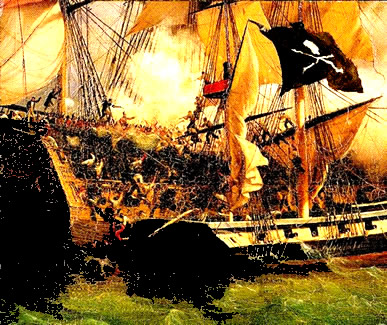
Artist: Ambroise-Louis Garneray -
Capture of Kent by Surcouf (c. 1850)
A number of pirates were took cargos that contained tobacco. In 1689, pirate Thomas Pound took the brigantine Merrimac, "the vessel was plundered of twenty half-barrels of flour, and sugar, rum and tobacco."5 Pirate Richard Harris of Bartholomew Roberts' crew beat a merchant ship's carpenter over "some Tobacco that was in the Chest, that he [the carpenter] would have defrauded him of."6 Harris was claiming that the carpenter was trying to hide the tobacco from him, although he seems to have been more interested in being contrary than actually concerned about tobacco based on the account. Captain Thomas Spenlow testified that John Rackham's pirates "took out of his said Scooner, Fifty Rolls of Tobacco, and Nine Bags of Piemento, and kept him in their Custody about Forty eight Hours"7.
Captain Stede Bonnet took two Scottish ships "bound from Virginia for Glascow, whose Names or Masters can’t remember, and took about one hundred Weight of Tobacco out of each, and then discharged them."8 A news report noted in 1723 that Edward Low's crew that "the Merry Christmas and the Bailey (the former of which had on board 600, and the latter 500 Hogsheads of Tobacco) have been plundered by one Lowe a Pirate."9
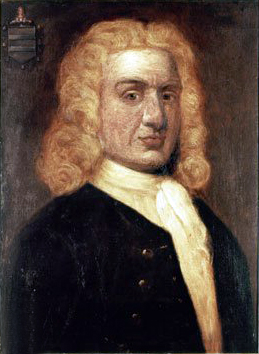
Captain William Kidd
While off Calcutta, India in December 1697, William Kidd's pirates took out of a unnamed 'Moorish' vessel described as a ketch "thirty Tubs of Sugar-Candy, of the Value of fifteen Pounds of lawful Money of England, six Bales of Sugar, of the value of six Pounds of lawful Money of England, and ten Bales of Tobacco, of the Value of ten Pounds of lawful Money of England"10. It is elsewhere noted that he tobacco and candy was not sold for profit, instead being shared among the Kidd's sailors.11
Howell Davis actually gave a merchant captain some tobacco in exchange for other goods he wanted. The pirates had taken a vessel belonging to Captain Knott, from whom they "plundered the greatest Part of his own private Adventure on board his Ship, and of all his Stores of Liquors, as well as of some ready Money and wearing Apparel; the Pyrates gave him by way of Recompence 10 Chests of Sugar, and 10 Rolls of Brasil Tobacco, 30 Moiders, and some Gold Dust"12. While this may sound like a trade, it was likely more of a ruse; by giving Knott something, the pirates could claim they hadn't plundered his ship, but traded with him. Unfortunately the victim wasn't given a choice of what he was to receive in exchange for his goods. Even more curious, the Hellana of New York reported that a group of pirates who had captured her in 1723 as she was sailing from Maryland, had also "taken 4 English Vessels within the Cape (probably Cape Charles), out of one of them they threw over board a great quantity of Tobacco"13. Perhaps they had enough for their own use and didn't find the cargo as potentially profitable as other cargos they had available to them.
1 William Funnell, A Voyage Round the World, 1969, p. 32; 2,3 Woodes Rogers, A Cruising Voyage Round the World, 1712, p. 147; 4 Edward Cooke, A Voyage to the South Sea and Round the World in the Years 1708 to 1711, 1969, p. 363; 5 George Francis Dow and John Henry Edmonds, The Pirates of the New England Coast 1630-1730, 1996, p. 60; 6 Pyrates Lately taken by Captain OGLE, 1723, p. 56; 7 The Tryals of Captain John Rackam, and Other Pirates, 1721, p. 18; 8 “22. David Herriot and Ignatius Pell on Blackbeard and Stede Bonnet, from The Tryals of Major Stede Bonnet, and other Pirates (London, 1719), pp. 44-48”, Pirates in Their Own Words, Ed Fox, ed., 2014, p. 100-1; 9 London Journal, 8-10-23, Issue CCXI; 10 The Arraignment, Tryal and Condemnation of Captain William Kidd, p. 37; 11 Tryal of Kidd, p. 54; 12 The Daily Courant, Wednesday, August 31, 1720; 13 The Post Master, 5-21-1700 - 5-23-1700

